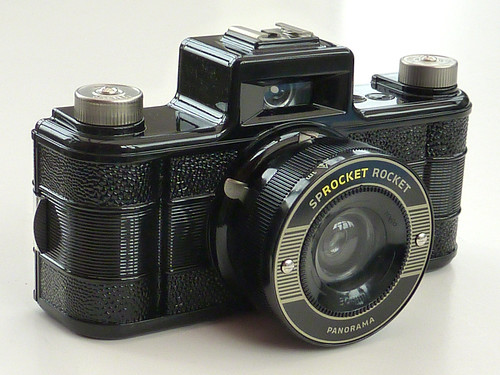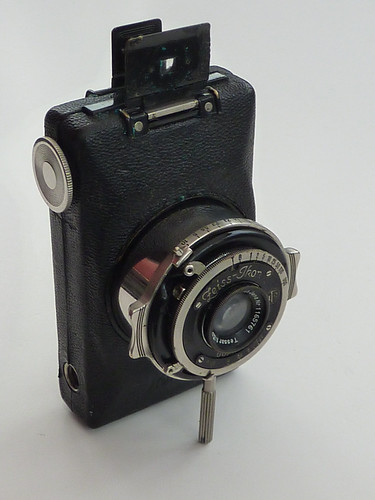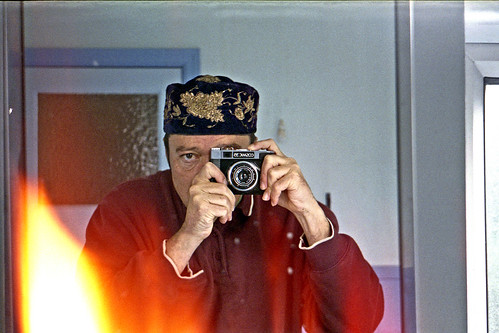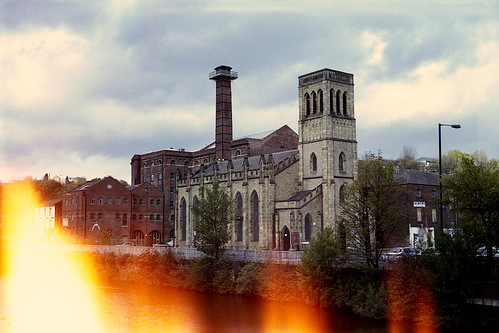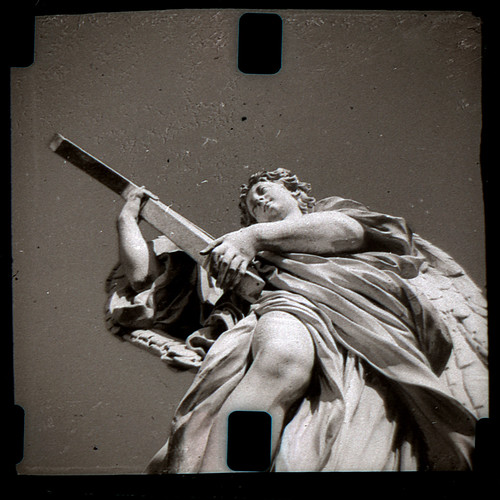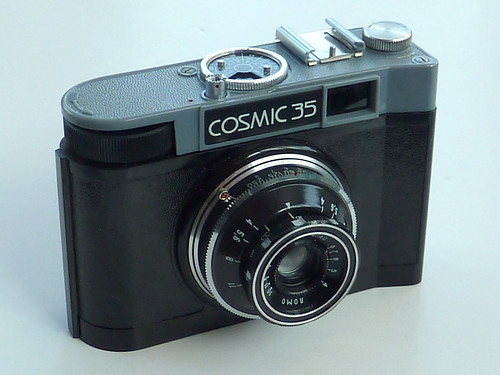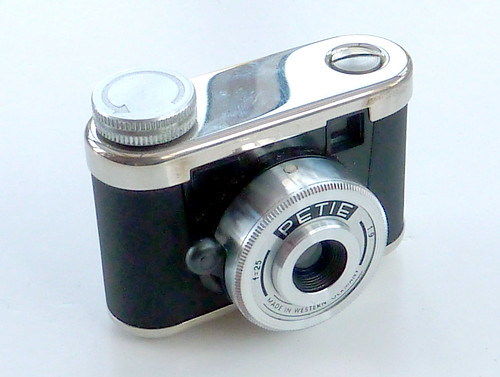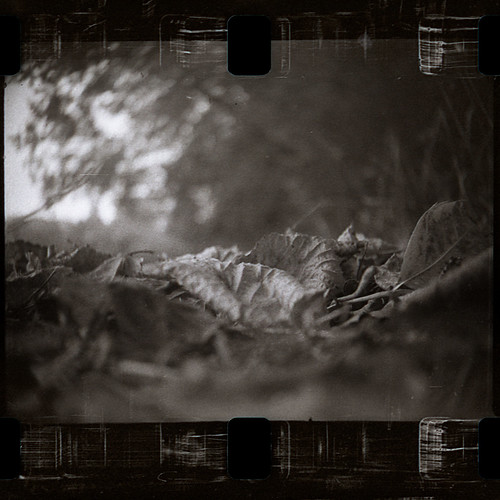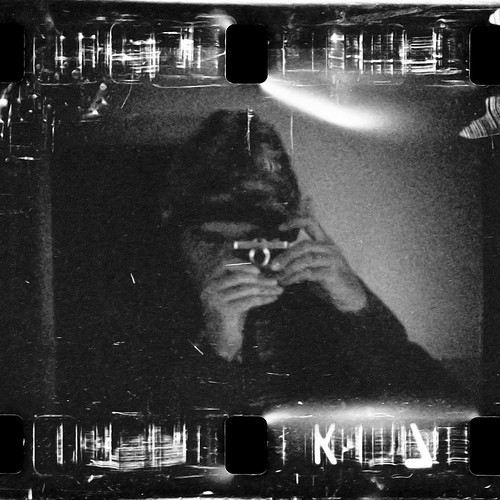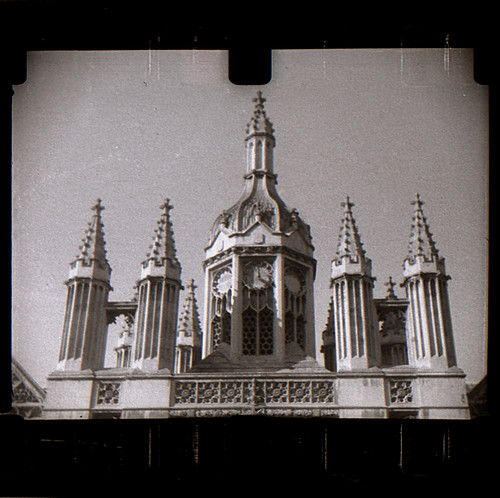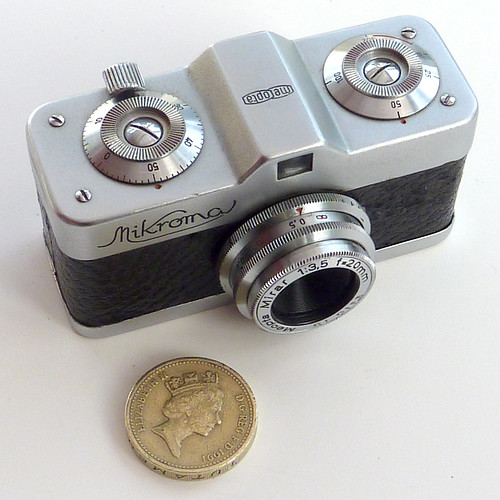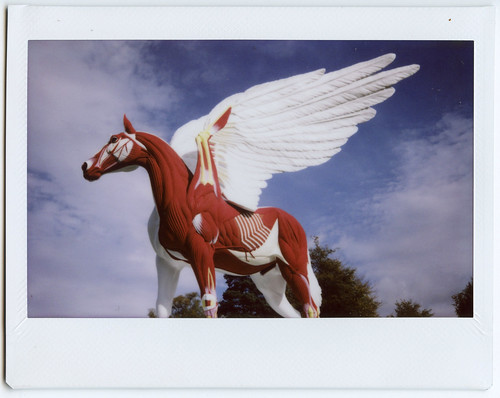Production of new film cameras has plummeted since the advent of digital photography, novelty models being one of the few areas to be expanding. The Lomography Society International is often credited with reviving interest in film photography through advocating a lo-tech, shoot anything, take the camera everywhere approach, which they originally made popular with the Russian Lomo LCA, an automatic camera not dissimilar in specification to the Olympus XA series. Recently the company have been selling new designs, this one, the Sprocket Rocket, has a panoramic format and includes the full height of the 35mm film, sprocket holes and all, in the image. People have been including sprockets in their photos for some time by loading medium format cameras with 35mm film, but the disadvantage of that is that the lens then has a relatively long focal length, the Sprocket Rocket gets around this by having a 30mm lens, giving a wide field of view, though image quality away from the centre is poor. I try to find subjects where the sprocket holes can become part of the composition.
I bought this camera new in June this year, and have already had several films through it.
Sunday 30 October 2011
Sunday 23 October 2011
Week 95 - Zeiss Ikon Kolibri
This is a lovely little camera dating from the 1930s, it takes 127 rollfilm, and has a lens which retracts into the body when not in use. The slow shutter speeds are unreliable, but otherwise it seems to work. I will be loading it with Efke 100 Blakc and white film.
photo from week 94 - Cosmic 35
The multiple light leaks on this frame are because I was trying out a muliiple click technique on the next couple of frames, whereby the film is advanced a small amount before re-firing the shutter.
Saturday 22 October 2011
photo from week 94 - Cosmic 35
I could see as soon as I took the film out of the developing tank that there was a significant light leak in this camera. It seems to come from the right hand side of the back cover (as seen with the camera pointing away from me). The leak is attenuated towards the bottom of the negative (top of the image whenseen the right way up) due to protection from light from the camera case.
Tuesday 18 October 2011
photo from week 93 - Petie miniature camera
This camera is so tiny, that for several hours I was convinced that I had lost it. After searching through the suitcases and bedside cabinets, I eventually found it in the pocket of the trousers I had been wearing throughout!
photo from week 93 - Petie miniature camera
Another photo from my brief trip to Rome with this tiny camera.
photo from week 93 - Petie miniature camera
I shot the roll of re-spooled FP4 in Rome, the conditions were full sunshine, and the camera coped well. There are many dust spots and blemishes, presumably due to fumbling around in a changing bag to re-spool the film.
Monday 17 October 2011
Week 94 - Cosmic 35
The Cosmic 35 is one of many similar models made in the Soviet Union in the 1970s and 80s, this model was also called the "Smena 8" in some countries. With a 40mm f4 lens, and shutter speeds from 1/15th - 1/250th, it can be used in a range of lighting conditions. There is no double exposure prevention, so it is possible to fire the shutter as many times as you like before advancing the film, I intedne to try some double/multiple exposures this week. I've loaded it with some expired "Boots" ISO200 colour negative film.
Saturday 8 October 2011
Week 93 - Petie miniature camera
These toy cameras were made in Germany in large numbers in the 1950s and 60s, they were sold under various names, and some of the later models had more than one shutter speed or aperture.
The film is a proprietary format using 17mm film wide on a spool with backing paper. Fortunately my camera came with four unused rolls of film, with expiry dates of 1964. I have managed to get images from older stock than this, so was cautiously optimistic that they might be usable, but there was only a trace of a picture to be seen. Film loses speed as it ages, a rule of thumb is to allow one stop per decade, but this camera has only one shutter speed and no "B" setting, so it was impossible to compensate for this loss of sensitivity.
I have re-rolled that old spools and backing papaer with some of the 40 year old FP4 16mm movie film that I used last week, I've already shot one test roll, so I know it works. The film has perforations, unlike the original, but this shouldn't be too much of a problem.
The film is a proprietary format using 17mm film wide on a spool with backing paper. Fortunately my camera came with four unused rolls of film, with expiry dates of 1964. I have managed to get images from older stock than this, so was cautiously optimistic that they might be usable, but there was only a trace of a picture to be seen. Film loses speed as it ages, a rule of thumb is to allow one stop per decade, but this camera has only one shutter speed and no "B" setting, so it was impossible to compensate for this loss of sensitivity.
I have re-rolled that old spools and backing papaer with some of the 40 year old FP4 16mm movie film that I used last week, I've already shot one test roll, so I know it works. The film has perforations, unlike the original, but this shouldn't be too much of a problem.
Thursday 6 October 2011
photo from week 92 - Mikroma miniature camera
The Mikroma focuses down to 50cm, so at near full aperture I was hoping to get a very narrow depth of field when I put the camera on the ground amongst the autumn leaves.
photo from week 92 - Mikroma miniature camera
Taken indoors, I knew this photo was going to be underexposed, looking at the negative, it is almost blank, Photoshop has rescued the ghost of the image, but the quality is pretty poor.
photo from week 92 - Mikroma miniature camera
The 40 year old FP4 has survived remarkably well, I developed the film in Ilfosol 3 and then scanned the negatives at 3600dpi. There are lots of scratches near the edges of the film, I think this must be due to scraping along the margins of the film plane, which would not appear in the picture area, but can be seen on the full width scans.
Sunday 2 October 2011
Week 92 - Mikroma miniature camera
I've had this camera for a couple of years, but have been waiting until I could get hold of some affordable 16mm film before using it. The camera was made in the 1950s in Czechoslovakia. This is the first Mikroma model, with a limited range of shutter speeds, the Mikroma II had a seven speed shutter. It uses 16mm film loaded into proprietary cassettes, luckily there were a pair in the camera, less luckily one of them is for a different model, so doesn't fit! I was able to get around this problem by using a "naked" take up spool instead of a cassette, which means that I have to unload the camera in total darkness, but that doesn't really matter.
I've already done a trial run with some of the 40 year old FP4 film that I bought, so I know the camera works. The use manual tells you what length of film to use for a given number of exposures, the maximum being 90cm for 50 exposures, which is roughly what I've loaded it with.
I've already done a trial run with some of the 40 year old FP4 film that I bought, so I know the camera works. The use manual tells you what length of film to use for a given number of exposures, the maximum being 90cm for 50 exposures, which is roughly what I've loaded it with.
Saturday 1 October 2011
photo from week 91 - Fuji Instax 200
Another sculpture from the "Beyond Limits" exhibition at Chatsworth House.
photo from week 91 - Fuji Instax 200
Holding up the not quite fully developed print of the church I had just photographed.
photo from week 91 - Fuji Instax 200
This reflected self portrait was taken in a shiny metal sculpture at Chatswoth House in Derbyshire. It shows that the camera is quite large!
Subscribe to:
Posts (Atom)
